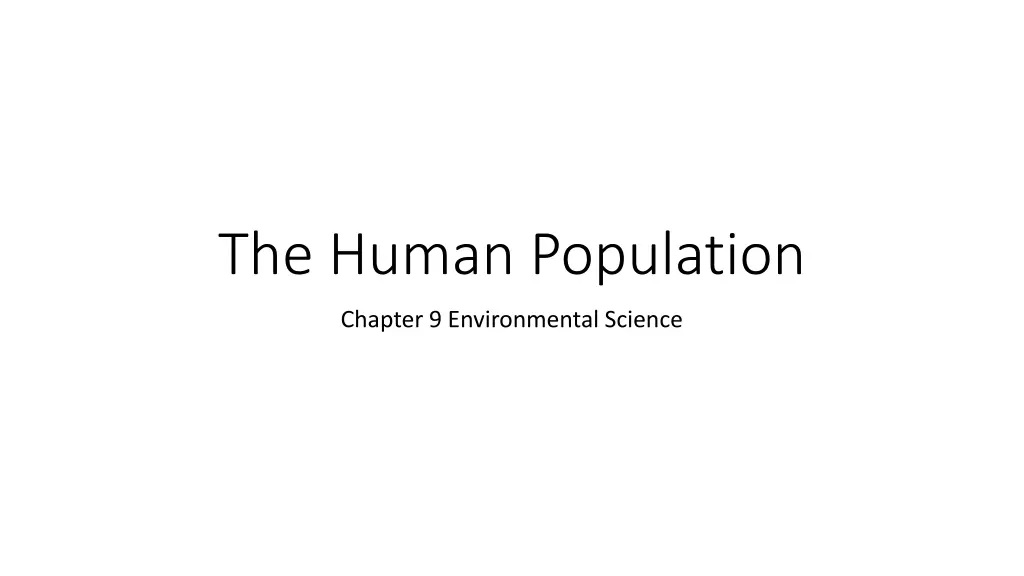
Human Population and Sustainability: Understanding Limiting Factors for 2050
Explore the impact of limiting factors on the human population's carrying capacity and sustainability. Learn about age-structure diagrams, survivorship curves, fertility rates, and demographic transitions. Students analyze social, environmental, and economic factors, proposing solutions for 2050 challenges.
Download Presentation

Please find below an Image/Link to download the presentation.
The content on the website is provided AS IS for your information and personal use only. It may not be sold, licensed, or shared on other websites without obtaining consent from the author. If you encounter any issues during the download, it is possible that the publisher has removed the file from their server.
You are allowed to download the files provided on this website for personal or commercial use, subject to the condition that they are used lawfully. All files are the property of their respective owners.
The content on the website is provided AS IS for your information and personal use only. It may not be sold, licensed, or shared on other websites without obtaining consent from the author.
E N D
Presentation Transcript
The Human Population Chapter 9 Environmental Science
10/5 Forecasting Population Size CH 9.1 Obj. TSW compare Age-Structure Diagrams, survivorship curves and fertility rates of populations. P. 68 NB 1. What information does an Age-structure diagram have for us? 2. What does the survivorship curves I, II, III tell you about the population? 3. Describe the fertility rate.
Journey 2050 - Sustainability Copy Each of the 12 Limiting Factors for the Human Population s Carrying Capacity Research with 1 2 students: Social, Environmental, Economic What is this limiting factor? Explain how we use it/ need it. How much do we have now? What will be need in 2050? How can we meet the need in 2050, what resources do we have, or do we need? Be prepared to present at the end of class and take notes on others presentations.
Sustainability Limiting Factors Explain how we use it/ need it. How can we meet the need in 2050? Page 73 NB Social Food: Tyra & Valyssia:1.6% land to produce food Education: Itzel & Samantha: CA education level US Health: Alicia: Jasmine, Gaby: Increasing Health access, Mexico Universal Health Care Infrastructure: Marcos & Isaaiah: Buildings & supplies, water, construction Environmental Water: Mariah, Patty: Pollution Drought, Acidification Habitats: Luke & Yajaira: Room for habitats for animals Health: Eric & Christian: Soil heath - Salinization, soil quality decreases, decrease carrying capacity GHG: Annie & Zehner: plant more trees to decrease CO 2 emissions. Reduces heat levels. Economic Jobs: Alicia & Eman: 6.2% unemployment in CA. One of highest in US. Rebuild infrastructure Profit: Angelo & Isabel: 7.5% US, CA 7.68% Profit is invested = Growth of Business. Income: Ethan, Daren:Pay for food/shelter/water. Income for US: 52,000 CA:$60,000 Community: Andrew & Jose: volunteer work, working together Unity. Communication, trading.
10/6 The Demographic Transition CH 9.1 Obj. TSW learn the 4 stages of the demographic transitions, and characteristics of each. P. 70NB 1. What is demographic transition? 2. Describe a characteristic of each stage in the demographic transition? 3. What countries might be in stages 2 4?
BRING STARBURSTS TO CLASS TOMORROW!! Carrying Capacity Activity: Page 75 NB Make a large circle outside. To survive of each organism requires 2 starbursts. In the third generation you are mature enough to reproduce. Each child costs 1 starburst to make and 1 more to maintain, If you do not get two starbursts, the child dies. (4 total for you and your offspring). The round lasts 15 seconds. Once you collect 2 starbursts runback to the outside and place them on the sidewalk, then go back for more. Return your starburst back to the center
10/7 Changing Population Trends CH 9.2 Obj. TSW analyze problems of rapid human growth, characteristics of undeveloped countries and compare growth rates of regions. P. 72NB 1. Describe three problems caused by rapid human population growth. 2. How does the United Nations identify the least developed countries? Figure 2.5 Growth Rates Which region will contribute most to the World Population Growth? 3.
Studying Studying H Human Populations p.69 NB uman Populations p.69 NB How have each one of these topics impacted the population of humans on the planet? Write one interesting fact for that topic. Bubonic Plague Industrial Revolution The Ratio between Males and Females Carrying Capacity & Sustainability Less-Developed Nations and Population
Relate Tragedy of the Commons to the Carrying Capacity game yesterday and Sustainability. P. 75 NB Instant Gratification I feel good now. I can wait for something better in the future Planning/ Investing Education Invest in yourself Job Just over Broke Career Future benefits Retirement: Benefits- Health, Vision, and Dental
Taboo Sustainability Tragedy of the Commons Carrying Capacity Population Demography
Taboo Undeveloped country Limiting Factor Exponential growth Fertility Demographic Transition
10/9 Managing Development and Population Growth CH 9.2 Obj. TSW learn and understand how countries are trying to control their population, why fertility rates are dropping and populations of people have become extinct. P. 74 NB EASTER ISLAND 1. Name 3 strategies Thailand has to used to control it s population growth? 2. Figure 2.8 Worldwide Trends in Fertility. Why are most countries fertility rates dropping to replacement levels? 3. Lost Populations, What Happened? P. 233 How is the Tragedy of the Commons related to Carrying Capacity of the Human Population?
Activity: Graphing the Human Population 2050 P. 79 NB CH 9 P. 289 Use the data to graph the number of people in the world. Add 2015 = 2.26 Billion People Use Excel What is the shape of the graph?
How could Tragedy of the Commons happen again to a human population?
List three steps you can take to be more sustainable.
